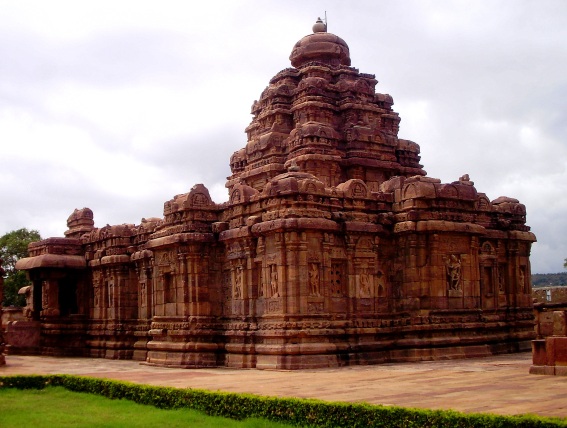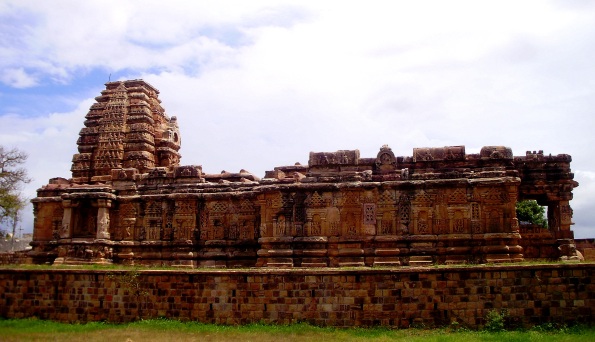I am not of the religious type; religious, as in one who regularly visits temples or carries out ceremonious pujas or makes oblations to any ‘representative’ of the almighty. In fact I avoid all of these. However, when it comes to ancient temples, it is a different story. My wanderlust has often taken me to ancient architectural sites and on most such occasions I have had plenty of reason to remain awe-stricken. The evidence of the humongous effort and dexterity of the ancient artisans, has always had me bowled over. I cannot help but sit in front of such a structure and gape in amazement at the magnitude of human craftsmanship. This happened with me again when I made a solo trip to the heartland of the ancient Chalukya dynasty – Badami (presently in Karnataka state of India).
From 500 AD to 757 AD a powerful dynasty ruled South India; the Badami Chalukyas whose most famous ruler was Pulakesin II. This dynasty not only established and sustained its stronghold over a large empire for over two and a half centuries, but ushered in an era of experimentation in temple architecture whose results stand even today as some of the most treasured heritages in India. The present day towns of Aihole and Badami and the village of Pattadakkal hold perhaps the highest concentration of ancient temples possible. It was during this era that temples of Nagara (North Indian) style and Dravida (South Indian ) style of architecture both flourished in the Chalukya heartland. From their experimentation was born a blend of these two styles that came to be known as the Chalukya style of temple architecture. This style originated at Aihole, and got perfected by the time it came to Badami and Pattadakkal. The group of monuments at Pattadakkal is now an UNESCO World Heritage Site.
A visit to these three places tells one why, this region is also called as the cradle of ancient Indian temple civilisation. It is said that Pulakesin’s brothers Vishnuvardhana and Jayasimha started the Eastern Chalukya dynasties of Andhra and Chalukya dynasty of Gujarat respectively. This had a positive effect on the exchange of architectural and sculptural styles that is evident in Badami.
The cave temples of Badami are examples not only of ultimate craftsmanship of the Chalukya period, but of the all embracing, tolerent social structure that defines India from time immemorial. Caves dedicated to Hinduism, Jainism and Buddhism replete with mythological and religious imageries and sculptings are simply magnificient. As I walked through these sites, I was struck by the richness of history that pervaded these places. It was history of not one period or of any one people that affected me but of the idea of an ancient Indian nation with all its layers of societal and demographic complexity prospering through harmonious coexistence. It is this resonance in every thread and every layer of the Indian fabric that has seen this nation withstand wave after wave of sweeping changes and centuries of foreign domination; and embrace the multitudes of resident peoples and cultures.
These photographs were taken in the historical sites of Badami and Pattadakal.

A Panorama of the Heritage Site at Pattadakal

The Galaganatha temple at Pattadakkal temple complex, built in the typical North Indian Nagara style of architecture.

The Sangameswara Temple at Pattadakal built in typical Dravida style.

Mallikarjuna Temple (Rear view) at Pattadakal

Papanatha Temple at Pattadakal

A closer look at the sculpted walls of the Virupaksha Temple at Pattadakal

Mallikarjuna temple (front view) at Pattadakal

Bhootanath Temple complex facing Agathya Teertha Lake at Badami.

A Shivalaya temple on the hill atop Badami Fort

Sculpture of an armed ‘Dvarpala’ (Guard) at Pattadakal
This post is in response to Daily post prompt Layers
Beautiful description, lucid writing powered by wonderful photography. Great one as usual Abhigyan.
LikeLike
Thanks Debatree
LikeLike
Beautiful description, lucid writing and wonderful photography
LikeLike
Absolutely beautiful craftsmanship. Thank you for sharing. I really enjoy seeing photo’s and hearing about other area’s of the world.
Blessings,
Laurie
LikeLike
Thanks Laurie for stopping by and commenting. Glad that you enjoyed it.
LikeLiked by 1 person
I really did. The detail amazes me, the skill and time required to build something of such magnificence.
LikeLike
Yeah, and the fact that these were built almost 1400 years ago when tools were much primitive., really naffles me.
LikeLiked by 1 person
Exactly. We have nothing that ancient here in the US. You are fortunate to live among such treasures.
LikeLike
You are right Laurie, i really am very lucky. That is the reason why it is my wish to travel and see as much as I can of my own country. There’s so much to see and know and yet very little free time to do so.
LikeLike
Free time is a challenge when we work. I have a lot more of my own country to see. I look forward to more of your essays.
LikeLiked by 1 person